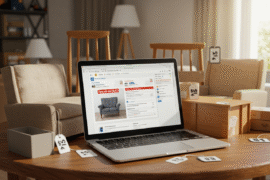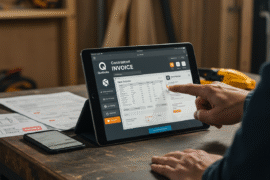This article may contain references to products or services from one or more of our advertisers or partners. We may receive compensation when you click on links to those products or services. Nonetheless, our opinions are our own.
The information presented in this article is accurate to the best of our knowledge at the time of publication. However, information is subject to change, and no guarantees are made about the continued accuracy or completeness of this content after its publication date.
- Key Highlights
- Introduction
- Understanding Dropshipping
- Benefits of Dropshipping
- Challenges of Dropshipping
- Beginner’s Guide to Starting Dropshipping
- Step-by-Step Guide/Process for Setting Up a Dropshipping Business
- Maintaining a Successful Dropshipping Business
- Conclusion
- Frequently Asked Questions
- Recommended Reads
Key Highlights
- Dropshipping allows people to sell products online without having to store stock.
- This business model is low-cost and works well for new businesses.
- Dropshippers rely on other suppliers to ship items instead of doing it themselves.
- Choosing the right niche is important to do well in the busy dropshipping market.
- Good customer service is essential, even if dropshippers don’t handle shipping.
Introduction
The dropshipping model is a well-liked option for anyone looking to start an online business. It lets you create an e-commerce business without the need to handle inventory. But is dropshipping a good fit for everyone? This blog post talks about the advantages and disadvantages. It can help you decide if this exciting business model suits you.
Understanding Dropshipping
Dropshipping lets you sell products online without having to hold any stock. Simply put, you act as a middleman. First, you create an online storefront. Then, you work with suppliers who take care of storage and shipping. When a customer buys a product, the supplier sends it directly. You make money by comparing the wholesale price and the retail price.
This easy process removes the need to store items, purchase stock, or handle shipping. You can then focus on marketing, sales, and customer service. This option is perfect for new e-commerce users.
Definition and Overview
Dropshipping is a way to run a business selling products without touching them. In your e-commerce business, you connect buyers with suppliers. You display products from suppliers in your online store. When someone buys a product, you order it from the supplier. The supplier then sends the item directly to the customer.
This model helps new commerce businesses begin. You do not need to buy inventory right away. This allows you to use your money for marketing and other critical areas. Dropshipping is a good choice for those starting their online selling journey.
The dropshipping model helps you run an e-commerce business more easily. Still, it’s crucial to understand both the benefits and disadvantages of this well-known business model before you invest your time and money in it.
How Dropshipping Differs from Traditional Retail
The main difference between dropshipping and traditional retail is how they manage inventory. A traditional retailer buys products and keeps them in stock. In contrast, drop shippers do not keep any items. They show products from suppliers on their online store and only buy an item from the supplier when a customer orders.
This key difference helps dropshippers keep their overhead costs low. They do not worry about warehousing, handling stock, or shipping. Because of this, they can offer lower prices, which can attract more customers to their store.
Traditional retailers have higher overhead costs. They spend money on rent, utilities, and employees to handle inventory. Because of these expenses, their prices are usually higher. This situation makes it hard for them to compete with the lower prices from the dropshipping model.
Benefits of Dropshipping
Dropshipping is popular today for several reasons. It is a great choice for people who want an affordable and flexible way to start a business. Setting up an online store without spending a lot of money at first is appealing. You can work from anywhere, making it even better.
You can easily add new products to your store without keeping any stock. This is a great option for entrepreneurs. Let’s take a closer look at these benefits to understand how they can help.
Low Initial Investment Required
One great thing about dropshipping is that it has low startup costs. You don’t need to buy a physical store or keep products in stock like you do with normal businesses. This helps people with less money begin their journey more easily.
As a drop shipper, your biggest costs come from starting your online store, promoting your products, and paying any fees from suppliers and your e-commerce platform. You only buy products after selling them, which allows you to have a higher profit margin than regular retail.
Low startup costs let you spend more money on marketing and attracting customers, which is crucial for succeeding in the tough e-commerce market.
Flexibility in Product Offerings
Dropshipping gives you a lot of freedom with your product offerings. You can quickly add new products to your store. You don’t need to worry about inventory or storage. This allows you to try out different niches. You can also test if a product is successful and react quickly to market trends.
If a product or category is not selling well, you can remove it from your store. This involves little risk. A quick response is essential because customer preferences can change easily.
This flexibility lets you concentrate on specific markets. You can also benefit from new trends. You don’t have to stress about unsold inventory.
Scalability Opportunities
Dropshipping is a great way to expand your e-commerce business, especially compared to traditional stores. As your business grows, you won’t need to spend money on extra space or inventory. Your suppliers take care of the shipping, letting you concentrate on adding more products and attracting more customers.
The dropshipping business model is simpler to grow than regular stores. When more customers come, you can manage more orders without needing a lot of extra resources.
This simple growth method helps you put your profits back into your online store, which will help it grow even more.
Reduced Overhead Costs
Running an online business using the dropshipping model is usually more affordable than having a regular retail store. You don’t have to maintain a physical location. This saves you money on rent, utilities, and employees.
Your biggest costs are running your e-commerce platform, marketing your products, and paying for dropshipping tools or services. This budget-friendly setup allows you to run your business from anywhere with an internet connection, offering greater flexibility.
When you keep your overhead costs low, you can spend more money on product research, marketing, and improving your online store, which can help increase your sales.
Voted "Best Overall Budgeting App" by Forbes and WSJ
Monarch Money helps you budget, track spending, set goals, and plan your financial future—all in one app.
Get 50% OFF your first year with code MONARCHVIP
Challenges of Dropshipping
Dropshipping has many appealing benefits. Still, new business owners must consider the challenges, too. The dropshipping model may seem simple, but it can have problems that affect earnings and success in the long run.
It’s good to understand the challenges before you start. Here are some important issues to keep in mind when starting a dropshipping business.
Dependency on Third-Party Suppliers
One big problem with dropshipping is relying on other suppliers for inventory and order fulfillment. This can simplify things, but it also means you must trust those suppliers to do their job well.
It is very important to find reliable suppliers. A supplier’s mistake, like sending the wrong product or having shipping delays, can hurt your brand image, even if the mistake was not your fault.
When choosing suppliers, it is important to do thorough research. Look for suppliers with a strong history of success and who communicate well. Focusing on customer needs can help prevent problems with product quality and other issues.
Issues with Inventory and Stock
Dropshipping lets you skip handling inventory yourself. However, this doesn’t mean you won’t face any problems. You depend on your supplier’s inventory management system. This can lead to issues, especially when you have different suppliers.
If your supplier does not update its stock levels, your online store might show incorrect information. This can cause order cancellations or delays and may frustrate customers.
Managing your online store’s inventory with several suppliers can be tough. It often requires special dropshipping tools or systems. To ensure you fill orders quickly and provide a good customer experience, you need to closely monitor stock levels from different suppliers.
Shipping Complexities
One big challenge for dropshippers is handling shipping problems. When they work with several suppliers, the shipping costs can differ. Each supplier might also have different delivery times and packaging methods.
Shipping differences can be confusing. This is common when a customer orders items from different suppliers. High shipping costs can affect your profits and cause potential customers to hesitate before buying.
Here’s an example of how shipping costs can vary:
| Supplier | Shipping Time | Shipping Cost |
|---|---|---|
| Supplier A | 5-7 business days | $5.99 |
| Supplier B | 7-10 business days | $8.99 |
| Supplier C | 3-5 business days | $12.99 |
It is important to be clear with your customers about shipping times and costs. By providing bundled shipping options, you can improve the customer experience. You can also offer free shipping on orders over a certain amount.
Customer Service Challenges
Customer service is essential in dropshipping, even if you aren’t the one shipping the products. You must answer customer questions, fix shipping problems, and handle returns properly. Good communication is key.
The supplier takes care of order fulfillment. If there are any problems, you must help the customer and the supplier. This process may take a lot of time, and if it is not done well, it can hurt customer satisfaction.
A system to track shipments, react quickly to customer problems, and show clear return and refund rules can greatly enhance customer support and help build brand loyalty.
Beginner’s Guide to Starting Dropshipping
Starting a dropshipping business needs good planning and a clear plan. This model is simple, but using a guide can help you succeed.
Here are the key resources and steps to begin your dropshipping business.
Essential Resources Needed to Begin
Before you start dropshipping, you need to know a few essential things. First, you need a good internet connection since your business will be online. Next, you should choose an e-commerce platform like Shopify, Wix, or WooCommerce. This platform will be the base for your online store.
Once you have your platform, it’s time to build your online presence. Pick a domain name that reflects your brand. Then, make a website that is easy to use and clearly showcases your products.
Finally, find reliable suppliers who provide quality products and deliver them fast. Remember to pay attention to marketing as well. Set aside some money to promote your dropshipping store and attract more visitors to your website.
Choosing the Right Niche and Products
Choosing the right niche and products is very important for your dropshipping business. You need to do market research to discover a niche market that is highly demanded but not too competitive.
Look for products that can give you good profits. Check the wholesale price and shipping costs. Also, think about how much you want to sell them for. Product quality is very important. Keep an eye on customer reviews and satisfaction. They are key to your success.
Think about targeting a specific group of people or a particular interest in your area. This approach will improve your marketing and allow you to connect with customers who truly want your products.
Step-by-Step Guide/Process for Setting Up a Dropshipping Business
Now that you know the main parts and challenges, let us follow a simple plan. This will help you build your dropshipping business. You need to pay attention to each step. This way, everything will go well and your business can grow successfully.
By following these steps closely, you can begin your dropshipping journey successfully.
Step 1: Selecting Your E-commerce Platform
The first step is to choose the best e-commerce platform for your online storefront. You have several options to look at. Each platform has its good and bad sides. Shopify is a well-liked choice. It is easy to use, has many apps, and dramatically supports dropshipping businesses.
Wix is a great option. It has an easy drag-and-drop design and offers low prices. If you know how to use WordPress, you might like WooCommerce. It lets you customize and manage your e-commerce website in many ways.
The best platform for you will depend on your budget, your technology skills, and how much you want to change them. Consider things like transaction fees, payment options, and how easy it is to link with dropshipping tools.
Step 2: Finding Reliable Suppliers
Partnering with trustworthy suppliers is very important for your dropshipping business. You should look into potential suppliers carefully and choose those who provide good products, quick shipping, and helpful customer service.
You might want to check out dropshipping supplier directories like SaleHoo, Worldwide Brands, or Spocket. These websites can help you find reliable suppliers that are close to you. You can also reach out directly to manufacturers or wholesalers offering dropshipping services.
When you check suppliers, remember to ask for product samples. This way, you can see the quality. It’s also good to find out about shipping times and costs. Read reviews from other drop shippers to get better information. Building strong relationships with your suppliers is really important. This makes it easier to solve problems quickly and ensures that customers have a good experience.
Step 3: Setting Up Your Online Store
After you choose your platform and suppliers, it’s time to create your online store. Select a nice theme that looks great on mobile devices. This theme should fit your brand identity and display your product range nicely.
Create clear product descriptions that highlight each item’s benefits and features. Include high-quality photos to grab your customers’ attention.
Make your e-commerce store easy to use. A simple checkout process is critical. Make sure there is a safe way to pay. Also, it is good to have clear rules for shipping and returns. A user-friendly design that looks professional can help you get more sales.
Step 4: Marketing Your Products
Marketing is very important for getting people to visit your online store and increasing sales. You need a good marketing plan. This plan should have social media marketing, search engine optimization (SEO), and paid ads.
Use social media like Facebook, Instagram, and Pinterest to connect with your target audience. Create fun and interesting content. Focus on your products, share useful information, and encourage people to engage with you.
Also, consider using Google Ads or ads on social media to make your store more visible. This can bring in the exemplary visitors. Make sure to check how well your marketing is doing. This will help you see what works best for your audience. Then, you can change your strategies if needed.
Step 5: Managing Orders and Customer Service
When your online store is ready, it is very important to manage orders well and provide great customer service. You should make a system for processing orders, tracking shipments, and answering customer questions.
Use dropshipping tools or integrations to simplify order fulfillment. This will benefit you and your customers. If there are any shipping delays or product issues, address them quickly.
Customer service must work to make customers happy. It is important to answer questions quickly, offer simple return and refund options, and try to solve any complaints. Good customer service can build trust and loyalty, which is key to the lasting success of your dropshipping business.
Maintaining a Successful Dropshipping Business
Building a successful dropshipping business is not just about starting it. You need to keep changing your strategies. This will help you stay ahead of your competition. It is also very important to focus on customer satisfaction.
Being proactive and looking for ways to make your work better is essential for lasting success.
Strategies for Long-Term Success
To make your dropshipping business successful for a long time, see it as something that often changes and needs updates. Keep checking your sales strategy. Find out what is effective and what isn’t. Then, adjust to increase your profits.
Don’t be afraid to try new product offerings or explore different marketing channels. It’s essential to change your target audience to fit market trends. Also, listen to customer feedback carefully.
Building a strong brand identity is very important. Keeping your customers loyal can help your business grow. Good customer service matters a lot. You should engage with your audience on social media. Also, create strong connections with your suppliers. This approach will help your business run smoothly and dependably.
Staying Competitive in the Market
The dropshipping business is very competitive. However, there are ways to stay on top. First, keep an eye on market trends. This will help you change your product offerings to fit what customers want.
You can be different by selling special or unique products. You might also consider offering personalized services. Try adding things like fast shipping, gift wrapping, or personal notes. These can improve the customer experience.
To stay ahead in your dropshipping business, watch for changes in your market and listen to what your customers want. This will help you beat the competition and find long-term success.
Continuously Evaluating and Expanding Product Lines
To stay ahead in the dropshipping market, you need to monitor your products’ sales and add new products that meet customer needs. This means you must also conduct regular market research and track the latest trends in your field.
Look at what your competitors are offering. Find spots in the market where you can do better. You might consider adding new product types similar to yours or creating bundles. This will help you give more value to your customers.
Keep in mind that what customers like can change over time. It’s crucial to stay flexible and change your offerings as needed. You should always try to be ahead by working on new products and offering a broad product range that truly connects with your audience.
Conclusion
In conclusion, dropshipping is a low-risk option for starting an online business. It requires a small investment and lets you be flexible with your product offerings. However, there are some challenges to think about. You need to rely on suppliers to handle shipping issues. To succeed in a dropshipping business, choose a good niche, focus on customer service, and regularly review and expand your product offerings to stay competitive. Starting this type of business needs careful planning when it comes to picking suppliers, creating your website, and planning your marketing strategies. You can build a successful dropshipping business model by using an innovative approach and adapting to market changes. Take a look at both the benefits and challenges before you embark on this exciting journey.
Frequently Asked Questions
What is the minimum budget to start a dropshipping business?
Starting a dropshipping business can be done with low startup costs. To manage your budget, focus on critical areas like an e-commerce platform, marketing, and basic business costs. It is vital to plan your budget and finances carefully.
Can dropshipping be a full-time career?
Dropshipping can become a full-time job for those working hard to create a successful business. The money you make depends on a few things. These include choosing the right niche, promoting your products well, and ensuring that your business is streamlined. It may not offer the same job security as traditional jobs, but it gives you a chance for career growth and a better balance between work and life.
How to handle returns and refunds in dropshipping?
Make sure your website has easy-to-understand return and refund policies. This way, customers will know what to expect. Talk openly with your supplier to make returns and refunds easy. Putting customer satisfaction first is key. Solving problems quickly helps maintain your business’s good name.
What are the common mistakes new dropshippers make?
New drop shippers often make critical mistakes. They might skip market research and pick unreliable suppliers. It’s significant to know about these mistakes. To avoid these problems, focus on careful planning, good quality control, and strong risk management.
How to choose trustworthy suppliers?
When choosing reliable suppliers, it is very important to closely check them. Look for good communication and positive feedback from them. Clear rules are important, too. You may want to ask for product samples. It’s also good to confirm their business credentials before starting a partnership.

Reviewed and edited by Albert Fang.
See a typo or want to suggest an edit/revision to the content? Use the contact us form to provide feedback.
At FangWallet, we value editorial integrity and open collaboration in curating quality content for readers to enjoy. Much appreciated for the assist.
Did you like our article and find it insightful? We encourage sharing the article link with family and friends to benefit as well - better yet, sharing on social media. Thank you for the support! 🍉
Article Title: Pros and Cons of Dropshipping: What You Should Know Before Diving In
https://fangwallet.com/2025/04/10/pros-and-cons-of-dropshipping/The FangWallet Promise
FangWallet is an editorially independent resource - founded on breaking down challenging financial concepts for anyone to understand since 2014. While we adhere to editorial integrity, note that this post may contain references to products from our partners.
The FangWallet promise is always to have your best interest in mind and be transparent and honest about the financial picture.
Become an Insider

Subscribe to get a free daily budget planner printable to help get your money on track!
Make passive money the right way. No spam.
Editorial Disclaimer: The editorial content on this page is not provided by any of the companies mentioned. The opinions expressed here are the author's alone.
The content of this website is for informational purposes only and does not represent investment advice, or an offer or solicitation to buy or sell any security, investment, or product. Investors are encouraged to do their own due diligence, and, if necessary, consult professional advising before making any investment decisions. Investing involves a high degree of risk, and financial losses may occur including the potential loss of principal.
Source Citation References:
+ Inspo
There are no additional citations or references to note for this article at this time.












































